2008 MERCEDES-BENZ SL ROADSTER belt
[x] Cancel search: beltPage 45 of 317
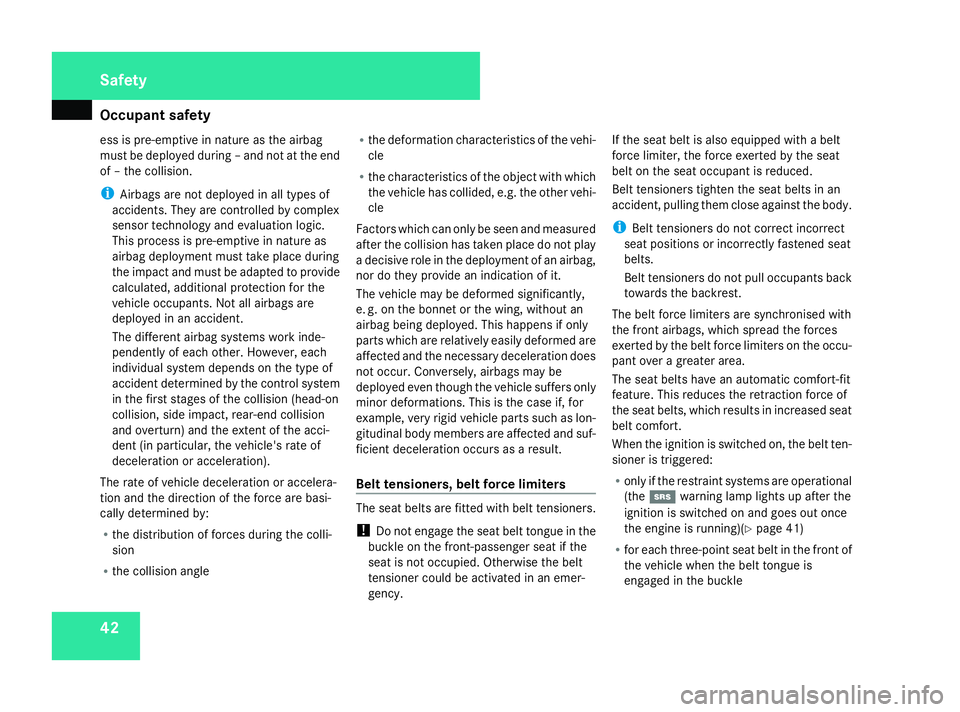
Occupant safety
42
ess is pre-emptive in nature as the airbag
must be deployed during –and not at the end
of –t he collision.
i Airbags are not deployed in all types of
accidents. They are controlled by complex
sensor technology and evaluation logic.
This proces sispre-emptive in nature as
airbag deployment must take place during
the impact and must be adapted to provide
calculated, additional protection for the
vehicle occupants. Not all airbags are
deployed in an accident.
The differen tairbag systems work inde-
pendently of each other .However, each
individual system depends on the type of
acciden tdetermined by the control system
in the first stages of the collision (head-on
collision, side impact ,rear-en dcollision
and overturn) and the extent of the acci-
dent (in particular, the vehicle's rate of
deceleration or acceleration).
The rate of vehicle deceleration or accelera-
tion and the direction of the forc eare basi-
cally determined by:
R the distribution of forces during the colli-
sion
R the collision angle R
the deformation characteristic softhe vehi-
cle
R the characteristic softhe objec twith which
the vehicle has collided, e.g. the other vehi-
cle
Factors which can only be seen and measured
after the collision has taken place do not play
ad ecisive role in the deployment of an airbag,
nor do they provide an indication of it.
The vehicle may be deformed significantly,
e. g. on the bonnet or the wing, without an
airbag being deployed. This happens if only
parts which are relatively easily deformed are
affected and the necessary deceleration does
not occur. Conversely, airbags may be
deployed even though the vehicle suffers only
minor deformations .This is the case if, for
example, very rigid vehicle parts such as lon-
gitudinal body members are affected and suf-
ficien tdeceleration occurs as aresult.
Belt tensioners, belt force limiters The seat belts are fitted with belt tensioners.
!
Do not engage the seat belt tongue in the
buckle on the front-passenger seat if the
seat is not occupied. Otherwise the belt
tensioner could be activated in an emer-
gency. If the seat belt is also equipped with
abelt
forc elimiter, the forc eexerted by the seat
belt on the seat occupant is reduced.
Belt tensioners tighten the seat belts in an
accident, pulling them close against the body.
i Belt tensioners do not correct incorrect
seat position sorincorrectly fastened seat
belts.
Belt tensioners do not pull occupants back
towards the backrest.
The belt forc elimiters are synchronised with
the fron tairbags, which spread the forces
exerted by the belt forc elimiters on the occu-
pant over agreater area.
The seat belts have an automatic comfort-fit
feature. This reduces the retraction forc eof
the seat belts, which results in increased seat
belt comfort.
When the ignition is switched on, the belt ten-
sioner is triggered:
R only if the restraint systems are operational
(the 1 warning lamp lights up after the
ignition is switched on and goes out once
the engin eisrunning)(Y page 41)
R for each three-poin tseat belt in the fron tof
the vehicle when the belt tongue is
engaged in the buckle Safety
230_AKB
;5;4,en-GB
bjanott, Version:2.9.6
2008-04-08T15:09:54+02:0
0-Seite 42 Dateiname: 6515_3089_02_buchblock.pdf; preflight
Page 46 of 317
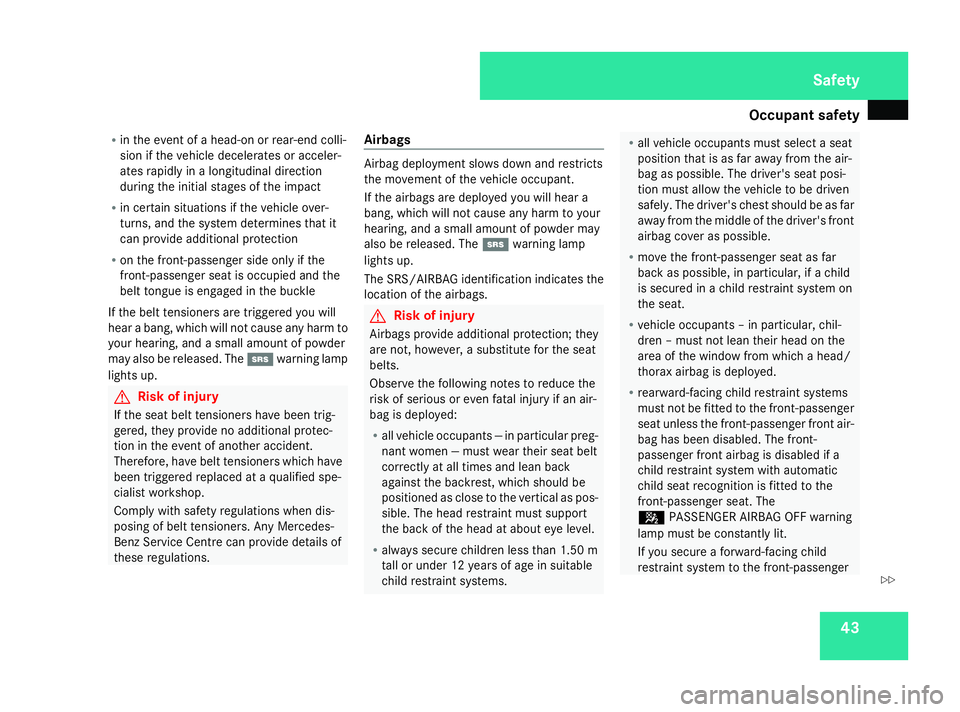
Occupant safety
43
R
in the event of ahead-on or rear-en dcolli-
sion if the vehicle decelerates or acceler-
ates rapidly in alongitudinal direction
during the initial stages of the impact
R in certain situation sifthe vehicle over-
turns, and the system determines that it
can provide additional protection
R on the front-passenger side only if the
front-passenger seat is occupied and the
belt tongue is engaged in the buckle
If the belt tensioners are triggered you will
hear abang, which will not cause any harm to
your hearing, and asmall amount of powder
may also be released. The 1warning lamp
lights up. G
Risk of injury
If the seat belt tensioners have been trig-
gered, they provide no additional protec-
tion in the event of another accident.
Therefore, have belt tensioners which have
been triggered replaced at aqualified spe-
cialist workshop.
Comply with safety regulations when dis-
posing of belt tensioners .Any Mercedes-
Ben zService Centr ecan provide details of
these regulations. Airbags Airbag deployment slows down and restricts
the movement of the vehicle occupant.
If the airbags are deployed you will hear a
bang, which will not cause any harm to your
hearing, and
asmall amount of powder may
also be released. The 1warning lamp
lights up.
The SRS/AIRBAG identification indicates the
location of the airbags. G
Risk of injury
Airbags provide additional protection ;they
are not ,however, asubstitute for the seat
belts.
Observe the following notes to reduce the
risk of serious or even fatal injury if an air-
bag is deployed:
R all vehicle occupants —inparticular preg-
nant women —must wear their seat belt
correctly at all times and lean back
against the backrest, which should be
positioned as close to the vertical as pos-
sible. The head restraint must support
the back of the head at about eye level.
R alway ssecure children less than 1.5 0m
tall or under 12 years of age in suitable
child restraint systems. R
all vehicle occupants must select aseat
position that is as far away from the air-
bag as possible. The driver's seat posi-
tion must allow the vehicle to be driven
safely. The driver's chest should be as far
away from the middle of the driver's front
airbag cover as possible.
R move the front-passenger seat as far
back as possible, in particular, if achild
is secured in achild restraint system on
the seat.
R vehicle occupants –inparticular, chil-
dren –must not lean their head on the
area of the window from which ahead/
thorax airbag is deployed.
R rearward-facing child restraint systems
must not be fitted to the front-passenger
seat unless the front-passenger fron tair-
bag has been disabled. The front-
passenger fron tairbag is disabled if a
child restraint system with automatic
child seat recognition is fitted to the
front-passenger seat. The
5 PASSENGER AIRBAG OFF warning
lamp must be constantly lit.
If you secure aforward-facin gchild
restraint system to the front-passenger Safety
230_AKB
;5;4,en-GB
bjanott, Version:2.9.6
2008-04-08T15:09:54+02:0
0-Seite 43 ZDateiname: 6515_3089_02_buchblock.pdf; preflight
Page 47 of 317
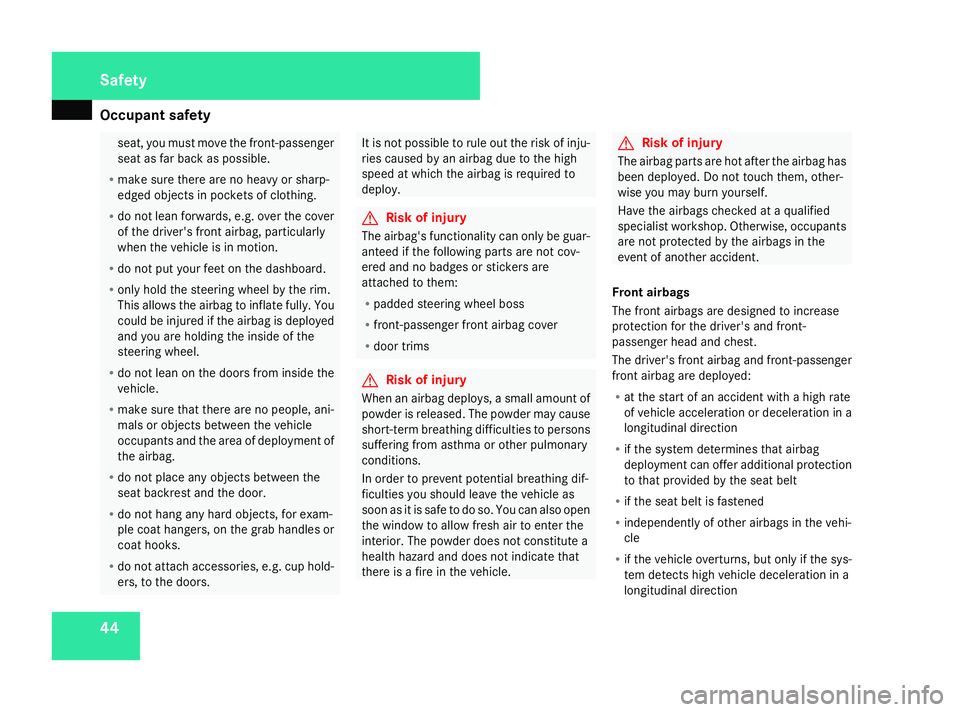
Occupant safety
44 seat, you must move the front-passenger
seat as far back as possible.
R make sure ther eare no heavy or sharp-
edged objects in pockets of clothing.
R do not lean forwards, e.g. over the cover
of the driver's fron tairbag, particularly
when the vehicle is in motion.
R do not put your feet on the dashboard.
R only hold the steering wheel by the rim.
This allows the airbag to inflat efully. You
could be injured if the airbag is deployed
and you are holding the inside of the
steering wheel.
R do not lean on the doors from inside the
vehicle.
R make sure that ther eare no people, ani-
mals or objects between the vehicle
occupants and the area of deployment of
the airbag.
R do not place any objects between the
seat backrest and the door.
R do not hang any hard objects, for exam-
ple coat hangers, on the grab handles or
coat hooks.
R do not attach accessories, e.g. cup hold-
ers, to the doors. It is not possible to rule out the risk of inju-
ries caused by an airbag due to the high
speed at which the airbag is required to
deploy. G
Risk of injury
The airbag's functionality can only be guar-
anteed if the following parts are not cov-
ered and no badges or stickers are
attached to them:
R padded steering wheel boss
R front-passenger fron tairbag cover
R door trims G
Risk of injury
When an airbag deploys, asmall amount of
powder is released. The powder may cause
short-term breathin gdifficulties to persons
sufferin gfrom asthma or other pulmonary
conditions.
In order to preven tpotential breathin gdif-
ficulties you should leave the vehicle as
soon as it is safe to do so. You can also open
the window to allow fresh air to enter the
interior. The powder does not constitute a
health hazard and does not indicat ethat
ther eisaf ire in the vehicle. G
Risk of injury
The airbag parts are hot after the airbag has
been deployed. Do not touch them ,other-
wise you may burn yourself.
Have the airbags checked at aqualified
specialist workshop. Otherwise, occupants
are not protected by the airbags in the
event of another accident.
Front airbags
The fron tairbags are designed to increase
protection for the driver's and front-
passenger head and chest.
The driver's fron tairbag and front-passenger
fron tairbag are deployed:
R at the start of an acciden twith ahigh rate
of vehicle acceleration or deceleration in a
longitudinal direction
R if the system determines that airbag
deployment can offer additional protection
to that provided by the seat belt
R if the seat belt is fastened
R independently of other airbags in the vehi-
cle
R if the vehicle overturns, but only if the sys-
tem detects high vehicle deceleration in a
longitudinal direction Safety
230_AKB
;5;4,en-GB
bjanott, Version:2.9.6
2008-04-08T15:09:54+02:0
0-Seite 44 Dateiname: 6515_3089_02_buchblock.pdf; preflight
Page 48 of 317
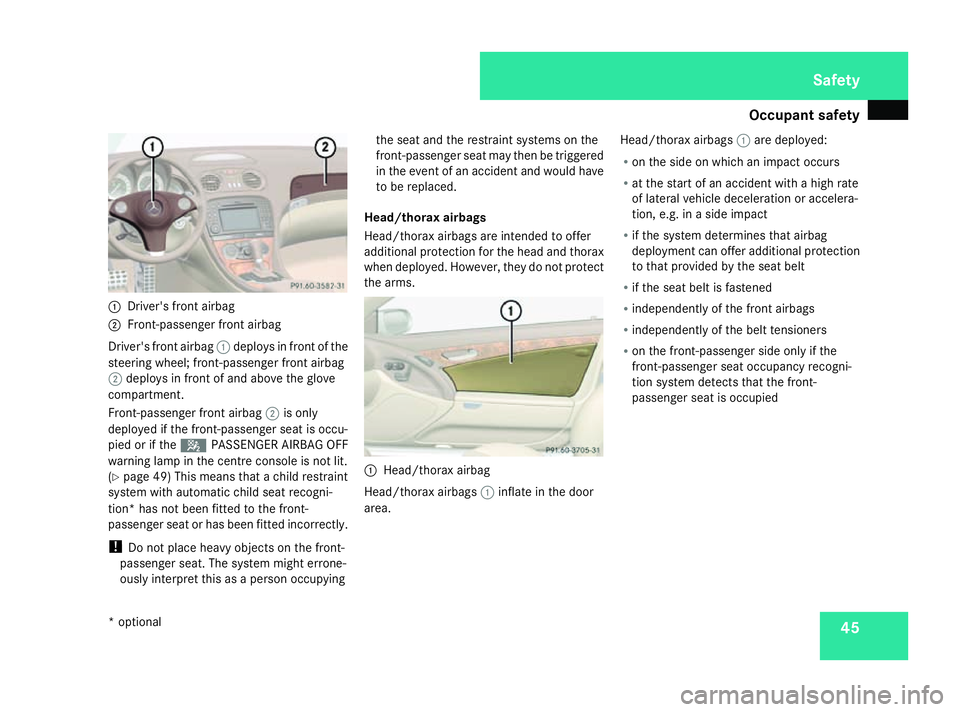
Occupant safety
451
Driver's front airbag
2 Front-passenger front airbag
Driver's front airbag 1deploysinf ront of the
steering wheel; front-passenger front airbag
2 deploysinf ront of and above the glove
compartment.
Front-passenger front airbag 2is only
deployed if the front-passenger seat is occu-
pied or if the 5PASSENGER AIRBAG OFF
warning lamp in the centre console is not lit.
(Y page 49) This means that achild restraint
system with automatic child seat recogni-
tion* has not been fitted to the front-
passenger seat or has been fitted incorrectly.
! Do not place heavy objectsont he front-
passenger seat. The system might errone-
ously interpret this as aperson occupying the seat and the restraint systems on the
front-passenger seat may then be triggered
in the event of an accident and would have
to be replaced.
Head/thoraxa irbags
Head/thorax airbags are intended to offer
additional protection for the head and thorax
when deployed. However, they do not protect
the arms. 1
Head/thorax airbag
Head/thorax airbags 1inflate in the door
area. Head/thorax airbags
1are deployed:
R on the side on which an impact occurs
R at the start of an accident with ahigh rate
of lateral vehicle deceleration or accelera-
tion, e.g. in aside impact
R if the system determines that airbag
deployment can offer additional protection
to that provided by the seat belt
R if the seat belt is fastened
R independently of the front airbags
R independently of the belt tensioners
R on the front-passenger side only if the
front-passenger seat occupancy recogni-
tion system detectst hat the front-
passenger seat is occupied Safety
*o ptional
230_AKB; 5; 4, en-GB
bjanott
,V ersion: 2.9.6
2008-04-08T15:09:54+02:00
-Seite 45 ZDateiname: 6515_3089_02_buchblock.pdf; preflight
Page 50 of 317
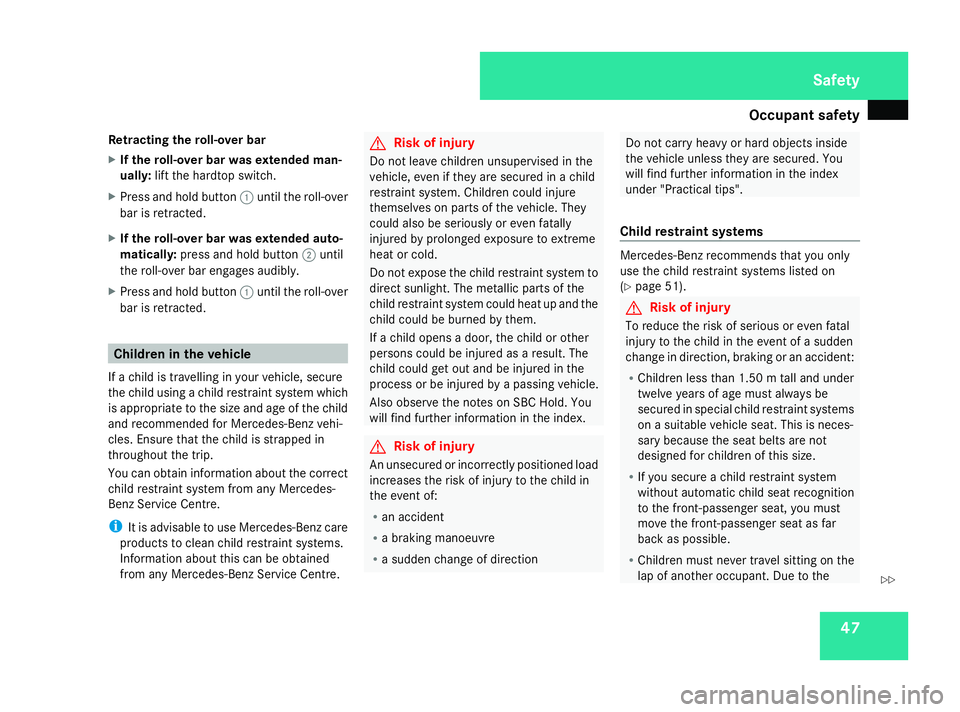
Occupant safety
47
Retracting the roll-over bar
X
If the roll-over bar was extended man-
ually: lift the hardtop switch.
X Press and hold button 1until the roll-over
bar is retracted.
X If the roll-over bar was extended auto-
matically: press and hold button 2until
the roll-over bar engages audibly.
X Press and hold button 1until the roll-over
bar is retracted. Children in the vehicle
If ac hild is travelling in your vehicle, secure
the child using achild restraint system which
is appropriate to the size and age of the child
and recommended for Mercedes-Benz vehi-
cles. Ensure that the child is strapped in
throughout the trip.
You can obtain information about the correct
child restraint system from any Mercedes-
Ben zService Centre.
i It is advisable to use Mercedes-Benz care
product stoclean child restraint systems.
Information about this can be obtained
from any Mercedes-Benz Service Centre. G
Risk of injury
Do not leave children unsupervised in the
vehicle, even if they are secured in achild
restraint system. Children could injure
themselves on parts of the vehicle. They
could also be seriously or even fatally
injured by prolonged exposure to extreme
heat or cold.
Do not expose the child restraint system to
direct sunlight .The metallic parts of the
child restraint system could heat up and the
child could be burned by them.
If ac hild opens adoor, the child or other
person scould be injured as aresult. The
child could get out and be injured in the
proces sorbei njured by apassing vehicle.
Also observe the notes on SBC Hold. You
will find further information in the index. G
Risk of injury
An unsecured or incorrectly positioned load
increases the risk of injury to the child in
the event of:
R an accident
R ab rakin gmanoeuvre
R as udden chang eofdirection Do not carry heavy or hard objects inside
the vehicle unless they are secured. You
will find further information in the index
under "Practical tips".
Child restraint systems Mercedes-Benz recommends that you only
use the child restraint systems listed on
(Y
page 51). G
Risk of injury
To reduce the risk of serious or even fatal
injury to the child in the event of asudden
chang eindirection, brakin goranaccident:
R Children less than 1.5 0mtall and under
twelve years of age must alway sbe
secured in special child restraint systems
on asuitable vehicle seat. This is neces-
sary because the seat belts are not
designed for children of this size.
R If you secure achild restraint system
without automatic child seat recognition
to the front-passenger seat, you must
move the front-passenger seat as far
back as possible.
R Children must never travel sitting on the
lap of another occupant. Due to the Safety
230_AKB
;5;4,en-GB
bjanott, Version:2.9.6
2008-04-08T15:09:54+02:0
0-Seite 47 ZDateiname: 6515_3089_02_buchblock.pdf; preflight
Page 52 of 317
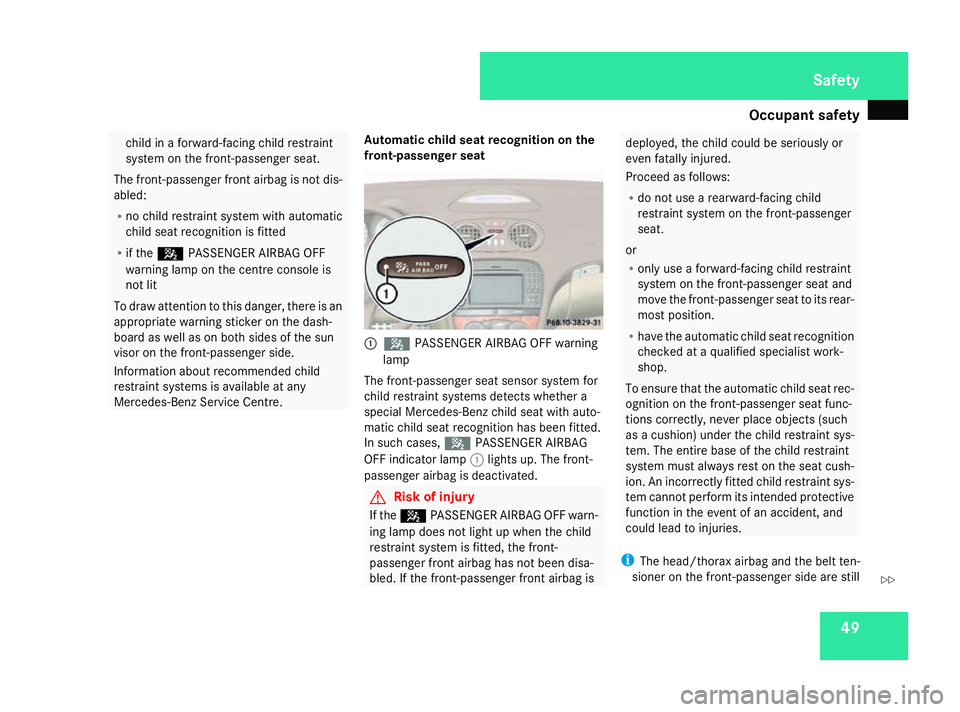
Occupant safety
49child in
aforward-facin gchild restraint
system on the front-passenger seat.
The front-passenger fron tairbag is not dis-
abled:
R no child restraint system with automatic
child seat recognition is fitted
R if the 5 PASSENGER AIRBA GOFF
warning lamp on the centre console is
not lit
To draw attention to this danger, ther eisan
appropriate warning sticker on the dash-
board as well as on both sides of the sun
visor on the front-passenger side.
Information about recommended child
restraint systems is available at any
Mercedes-Benz Service Centre. Automatic child seat recognition on the
front-passenger seat 1
5 PASSENGER AIRBAG OFF warning
lamp
The front-passenger seat sensor system for
child restraint systems detectsw hether a
special Mercedes-Benzc hild seat with auto-
matic child seat recognition has been fitted.
In such cases, 5PASSENGER AIRBAG
OFF indicator lamp 1lights up. The front-
passenger airbag is deactivated. G
Risk of injury
If the 5 PASSENGER AIRBAG OFF warn-
ing lamp does not light up when the child
restraint system is fitted, the front-
passenger front airbag has not been disa-
bled. If the front-passenger front airbag is deployed, the child could be seriously or
even fatally injured.
Proceed as follows:
R
do not use arearward-facing child
restraint system on the front-passenger
seat.
or
R only use aforward-facing child restraint
system on the front-passenger seat and
move the front-passenger seat to its rear-
most position.
R have the automatic child seat recognition
checked at aqualified specialist work-
shop.
To ensure that the automatic child seat rec-
ognition on the front-passenger seat func-
tions correctly, never place objects( such
as ac ushion) under the child restraint sys-
tem. The entire base of the child restraint
system must always rest on the seat cush-
ion. An incorrectly fitted child restraint sys-
tem cannot perform its intended protective
function in the event of an accident, and
could lead to injuries.
i The head/thorax airbag and the belt ten-
sioner on the front-passenger side are still Safety
230_AKB; 5; 4, en-GB
bjanott ,V ersion: 2.9.6
2008-04-08T15:09:54+02:00
-Seite 49 ZDateiname: 6515_3089_02_buchblock.pdf; preflight
Page 66 of 317
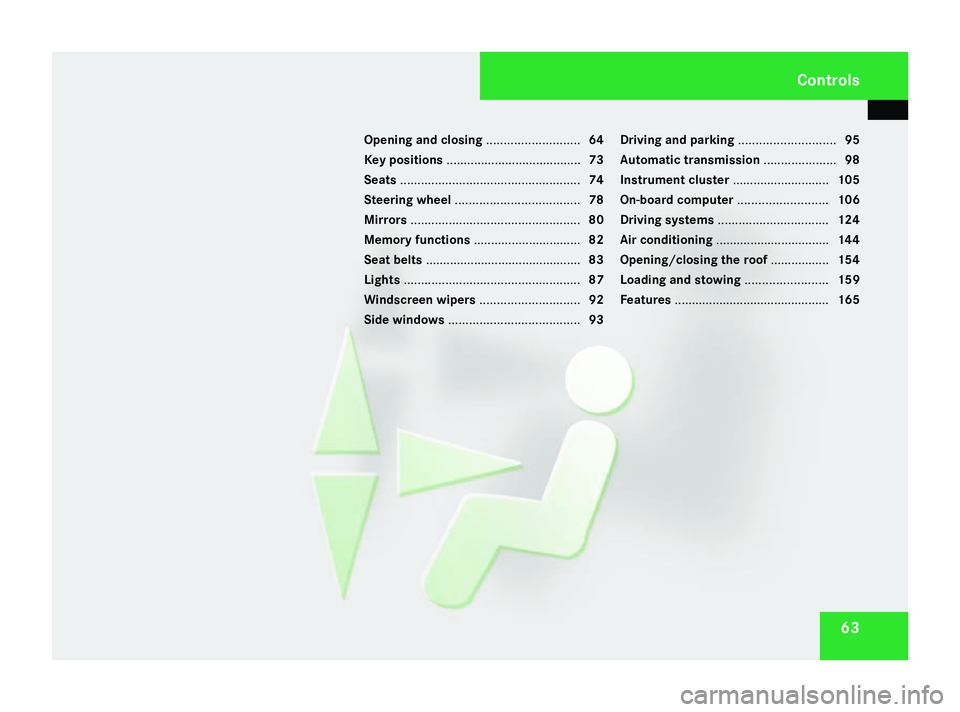
63
Opening and closing
...........................64
Key positions ....................................... 73
Seats .................................................... 74
Steering wheel .................................... 78
Mirrors ................................................. 80
Memor yfunctions ............................... 82
Seat belts ............................................. 83
Lights ................................................... 87
Windscreen wipers .............................92
Side windows ...................................... 93Driving and parking
............................95
Automatic transmission .....................98
Instrument cluster ............................105
On-boar dcomputer .......................... 106
Driving systems ................................ 124
Air conditioning ................................. 144
Opening/closing the roof .................154
Loading and stowing ........................159
Features ............................................. 165 Controls
230_AKB
;5;4,en-GB
bjanott, Version:2.9.6
2008-04-08T15:09:54+02:0
0-Seite 63 Dateiname: 6515_3089_02_buchblock.pdf; preflight
Page 86 of 317
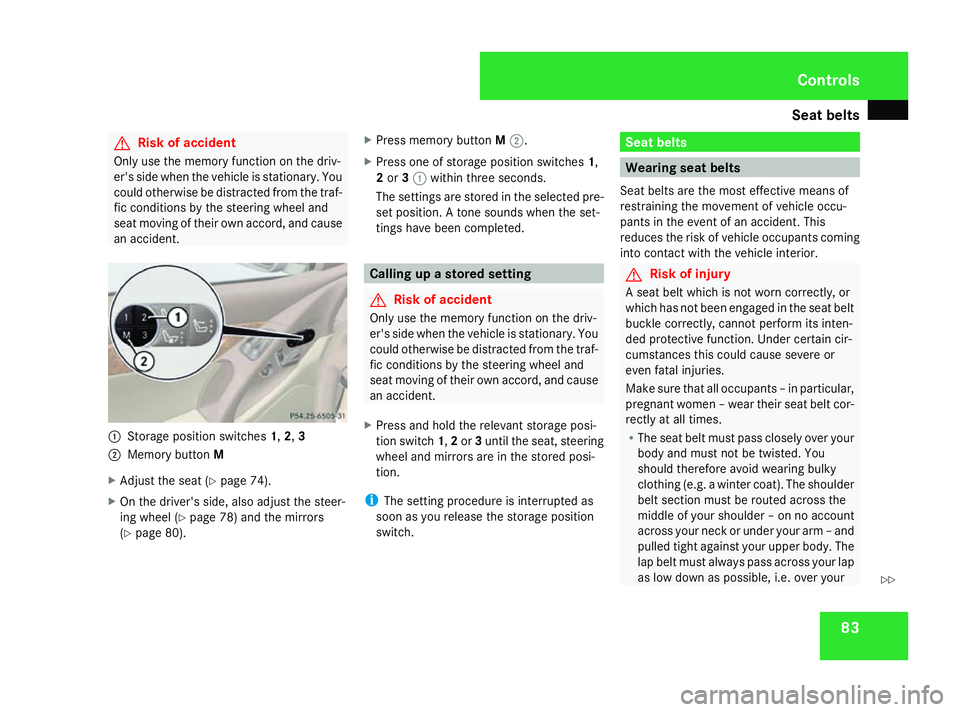
Seat belts
83G
Risk of accident
Only use the memory function on the driv-
er's side when the vehicle is stationary. You
could otherwise be distracted from the traf-
fic conditions by the steering wheel and
seat moving of their own accord, and cause
an accident. 1
Storage position switches 1,2,3
2 Memory button M
X Adjust the seat (Y page 74).
X On the driver's side, also adjust the steer-
ing wheel (Y page 78) and the mirrors
(Y page 80). X
Press memory button M2.
X Press one of storage position switches 1,
2 or 31 within three seconds.
The settings are stored in the selected pre-
set position. Atone sounds when the set-
tings have been completed. Calling up
astored setting G
Risk of accident
Only use the memory function on the driv-
er's side when the vehicle is stationary. You
could otherwise be distracted from the traf-
fic conditions by the steering wheel and
seat moving of their own accord, and cause
an accident.
X Press and hold the relevant storage posi-
tion switch 1,2or 3until the seat, steering
wheel and mirrors are in the stored posi-
tion.
i The setting procedure is interrupted as
soon as you release the storage position
switch. Seat belts
Wearing seat belts
Seat belts are the most effective means of
restraining the movement of vehicle occu-
pants in the event of an accident. This
reduces the risk of vehicle occupants coming
into contact with the vehicle interior. G
Risk of injury
As eat belt which is not worn correctly, or
which has not been engaged in the seat belt
buckle correctly, cannot perform its inten-
ded protective function. Under certain cir-
cumstances this could cause severe or
even fatal injuries.
Make sure that all occupants –inparticular,
pregnant women –weartheir seat belt cor-
rectly at all times.
R The seat belt must pass closely over your
body and must not be twisted. You
shouldt herefore avoid wearing bulky
clothing (e.g. awinter coat). The shoulder
belt section must be routed across the
middleofy ours houlder –onnoa ccount
across yourn eck or under youra rm–and
pulled tight against youru pperbody.T he
lap belt must always pass across yourl ap
as low down as possible, i.e. over your Controls
230_AKB; 5; 4, en-GB
bjanott,
Version: 2.9.6
2008-04-08T15:09:54+02:00
-Seite 83 ZDateiname: 6515_3089_02_buchblock.pdf; preflight